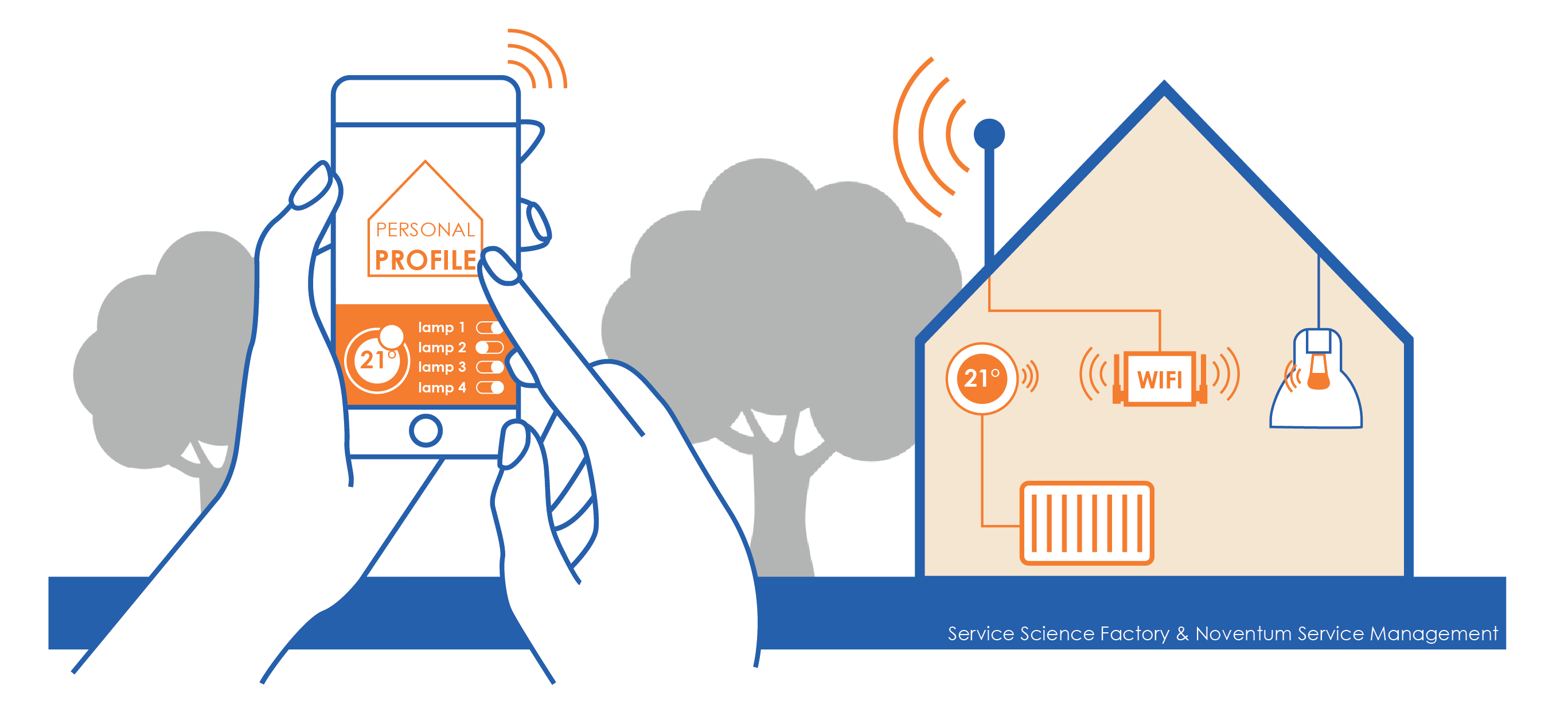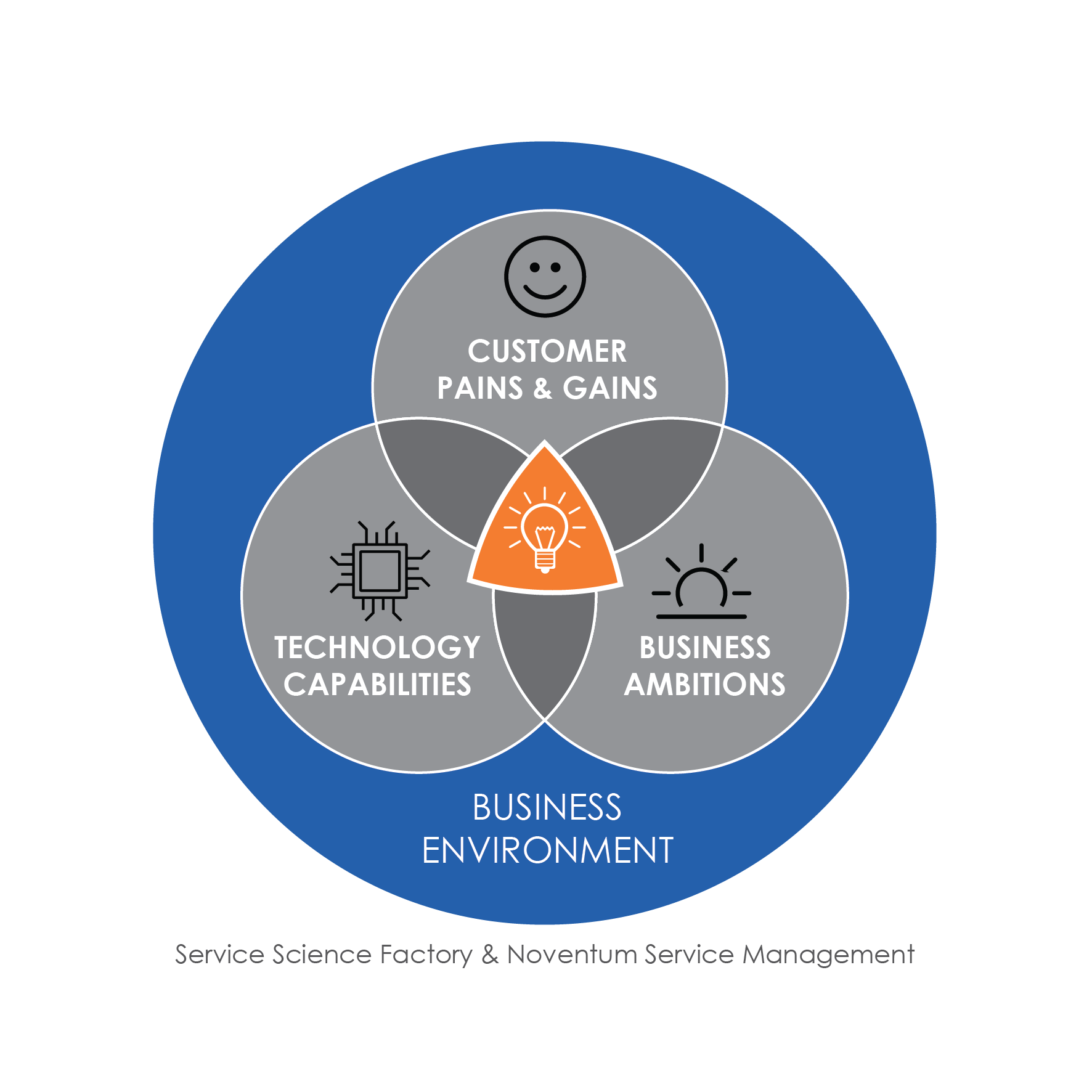By: Damien Nunes / Dominik Mahr / Rosanne Gresnigt
Recent advances in technology put Internet-of-things (IoT)-innovation on top of the management agenda across industries. It is predicted to increase economic value by $11.1 trillion in 2025 (McKinsey 2015). The Service Science Factory and Noventum collaborated on this article to present a state-of-the art view on the Internet of Things and how to implement this vision within organizations.
What is the Internet-of-Things (IoT) and why is it relevant?
Over the past years, computer technology has increasingly become a commodity as it has become cheaper, faster, more reliable, more efficient, smarter, smaller, portable and more connected. It gave the opportunity to add new capabilities to the things (products and machines) that make up our lives. Consumer focused examples are Philips Hue lights and the Nest Thermostat that receives information via your smartphone about when you are arriving and automatically lights and heats up your home. Furthermore, such systems can learn customer behaviour and act pro-actively, which can provide additional convenience for the customer.

However this is only a small part of the opportunities that IoT can bring. There are also examples of fully automated farms, dynamic production lines, smart trains, sustainable offices and examples of IoT implementations in Health Care. IoT-technology is evolving daily and impacting every sector. The basis of all these IoT innovations are the 6 principles listed below and the power of IoT is to combine them in such a way that they provide new services and capabilities that provide value for your customer and your organisation.

How can your organization take advantage of IoT?
“Many executives understand the urgency and know that they have to do something but it often remains unclear what and how” says Hilbrand Rustema, Managing Director at Noventum Service Management. Top management often delegates the development of (IoT) innovation to middle and lower management. Yet new ideas often face skepticism and even opposition across the firm: IoT innovation often disrupts work practices and current product and service portfolios, and can even cannibalize existing revenues, at least in short term. Some employees become worried about their jobs, and can even block innovations. Fresh ideas, awareness for opportunities and positive attitude across the organizations are a crucial breeding ground for such radical innovation. The Service Science Factory (an entity of Maastricht University which combines research, education and practice on service design and innovation) practices a process to develop this positive base for IoT innovation. The process is user-centered, employee-participative, explorative, iterative and routed in (service) Design thinking and its scientific research base.
How to uncover the potential of IoT for your organisation?
The model below can be used by your organisation and its employees to create a practical IoT-understanding by applying the six principles of the Internet of Things to the context of the organization.

1. Set business focus
IoT offers opportunities to realize a firm’s strategy and achieve its goals such as lower cost, customer delight or greater profit. To leverage these opportunities top management does not only need to commit to drive IoT innovation but also clearly determine the strategic goals it wants to reach.
2. Introduce IoT capabilities & Design Thinking
Before further embarking on this explorative journey it is important to recruit an inter-disciplinary team. Having various competences within the team is an essential element of the Design Thinking philosophy and will ensure that you incorporate various perspectives on the business challenge that has been set in the previous step.

The team should understand the potential capabilities of smart products and computer technology and the value drivers of their customers and the market they are operating in. Without learning how to think in networks and eco-systems and understanding the value and potential of data, employees will not know how IoT can be applied to the organization they work for. Reflecting on the principles of IoT and best practice cases is a good way to broaden the employees’ perspectives. In addition, without knowing what the value drivers for customers are, or what is happening in their business environment, companies might end up developing services for which there is no demand. Identifying the needs (pains) and ambitions (gains) of your customer should be the base from where you develop your IoT driven innovation, the selection should be based on the alignment with your brand values and business ambitions
3. Ideate IoT innovations
The field of (service) Design Thinking provides various ideation techniques which are used by the interdisciplinary team to spark creativity. This results in ideas that embody both the opportunities that IoT can provide as well as the various perspectives of the market and the organization. Mapping out the value proposition that the IoT innovation provides will help to always incorporate the customer perspective in the idea development.
4. Share, combine and prioritize ideas
The collective sharing of ideas strengthens the feeling of organization-wide involvement and the collective prioritization drives commitment. It is also an important moment to receive feedback and see if ideas can be strengthened by combining them with other ideas and initiatives that are present within the team and the organization.
5. Map the eco-system of the IoT innovation
IoT innovations typically involve a complex eco-system of actors, components and connections. Visually mapping out eco-systems (e.g. conceptual blueprints), on both macro as well as micro scale, reveals possible challenges and needed resources to realize the IoT innovation. Furthermore such visual blueprints make it much easier to discuss how the IoT will function and look like with team members and other stakeholders.
6. Identify the business implications
Understanding and showing the required investments, risks, and (possible) impact is a crucial part of the development of any innovation. Gate keepers within the organization want to know what the organizational implications are and what they can expect on their ‘return on investment’. Developing and validating the business case is a good way to convince important decision makers in the next step.
7. Pitch to important decision makers
For innovations to be implemented, ambassadors are needed to create internal alignment. Especially in large international organisations with multiple divisions and functions, this is critical to the success of any IoT initiative. Therefor pitch-like presentations towards (top) management and other parts of the organization are needed to create a coalition of the willing and obtain the funds needed for further development and implementation.
Where are we now?
In summary, the outcomes of the above process are not only great ideas but also cross-functional teams that take ambassadorship for their IoT innovations. The employees are made aware of the opportunities with IoT, will identify opportunities in their regular business and drive the change. Thereby your organisation is prepared for the service transformation. The seven-step process is in essence a process for changing the mindset towards an IoT future. In the end, your employees are the base for designing IoT Innovation – Not the technology.
How to move forward?
Once a new or improved IoT-driven service or business model has been identified, carefully selected and accepted throughout the organisation, the next step is to actually start the development and implementation of the new or improved service system. This usually has far broader implications than defining the value proposition, ecosystem and business case as the disruptive nature of IoT enabled business models often affect all areas of the organisation. The implementation therefore requires a clear strategy and roadmap including the definition of a clear marketing & sales strategy, the design of a detailed delivery model and the development of required human, system and organisational capabilities. Without a well prepared implementation strategy and an agile attitude towards unforeseen events you risk losing not only the momentum you created in the IoT-explore phase but also the return on investment of your new services portfolio.
About the authors
 Damien Nunes is project leader and a service designer at the Service Science Factory (SSF). SSF is an important valorisation entity within Maastricht University that focuses on service and business innovation in the form of projects, research and (post-graduate) education. Damien originally has an engineering and design background and developed himself further in the field of service and business innovation from a design thinking perspective.
Damien Nunes is project leader and a service designer at the Service Science Factory (SSF). SSF is an important valorisation entity within Maastricht University that focuses on service and business innovation in the form of projects, research and (post-graduate) education. Damien originally has an engineering and design background and developed himself further in the field of service and business innovation from a design thinking perspective.
 Dr. Dominik Mahr is Associate Professor at Maastricht University and Scientific Director of the Service Science Factory. The Service Science Factory (SSF) supports companies to identify business challenges and design service innovations. Being a part of Maastricht University SSF combines research, education and practice on service design and innovation.
Dr. Dominik Mahr is Associate Professor at Maastricht University and Scientific Director of the Service Science Factory. The Service Science Factory (SSF) supports companies to identify business challenges and design service innovations. Being a part of Maastricht University SSF combines research, education and practice on service design and innovation.
 Rosanne Gresnigt has an MSc in strategy & organisation with a focus on service management. As Consultant at Noventum Service Management she worked on service transformation projects in various manufacturing organisations across Europe. Key specialisations are: advanced service strategies, service life-cycle management and service marketing & sales development.
Rosanne Gresnigt has an MSc in strategy & organisation with a focus on service management. As Consultant at Noventum Service Management she worked on service transformation projects in various manufacturing organisations across Europe. Key specialisations are: advanced service strategies, service life-cycle management and service marketing & sales development.
Featured image via Yayimages.

